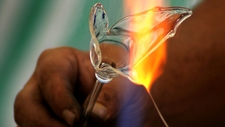Changing Materials

TEKS Objective
Demonstrate that things can be done to materials to change their physical properties such as cutting, folding, sanding, and melting.
Essential Understanding
The student knows that matter has physical properties and those properties determine how it is described, classified, changed, and used.
Science Background
Chemical vs. Physical Changes: CHEM4KIDS (website) - Physical changes do not change a substance’s chemical makeup. Learn how to distinguish physical and chemical changes.
Chemical vs. Physical Changes
by Andrew Rader, Chem4Kids, www.chem4kids.com
Signature Lesson
Melting and Freezing: Science NetLinks (website) - Students explore how melting and freezing impact everyday items as they change form a solid to a liquid or a liquid to a solid.
Melting and Freezing
Science NetLinks, www.sciencenetlinks.com
Materials and Manufacturing: Science NetLinks (website) - Students examine the properties, limitations and durability of various materials, and evaluate which materials would be best for building a model house.
Materials and Manufacturing
Science NetLinks, www.sciencenetlinks.com
- Supporting Lessons
- Extensions
- Assessment Ideas
- Literature Connections
- Related
TEKS - Additional Resources
Supporting Lessons
Recycled Materials: Science NetLinks (website) - Students learn that some materials can be recycled, and they investigate types of materials that can be reused, as well as potential uses for recyclable materials.
Recycled Materials
Science NetLinks, www.sciencenetlinks.com
Elaboration Lessons and Extensions
FOSS Paper and Wood Unit: FOSSWeb (website) - This unit explores the properties of wood and paper and how they are processed to create other materials.
Paper and Wood Unit
FOSSWeb, www.fossweb.com
Assessment Ideas
FOSS Paper and Wood Unit, Science Journal Questions: FOSSWEB (website) - This unit explores the properties of wood and paper and how they are processed to create other materials. This questionaire can be used to assess student understanding.
Literature Connections
Made in the USA: Recycled Paper. Woods, G. (ISBN-13: 978-1567113952)
Additional Resources
Where is Wood? FOSSWeb (website) - Select the “Where is Wood?” game on the left-hand menu and allow students to search for materials made from wood.
TEKS Navigation
Grade 2
Need Assistance?
If you need help or have a question please use the links below to help resolve your problem.

Comments